


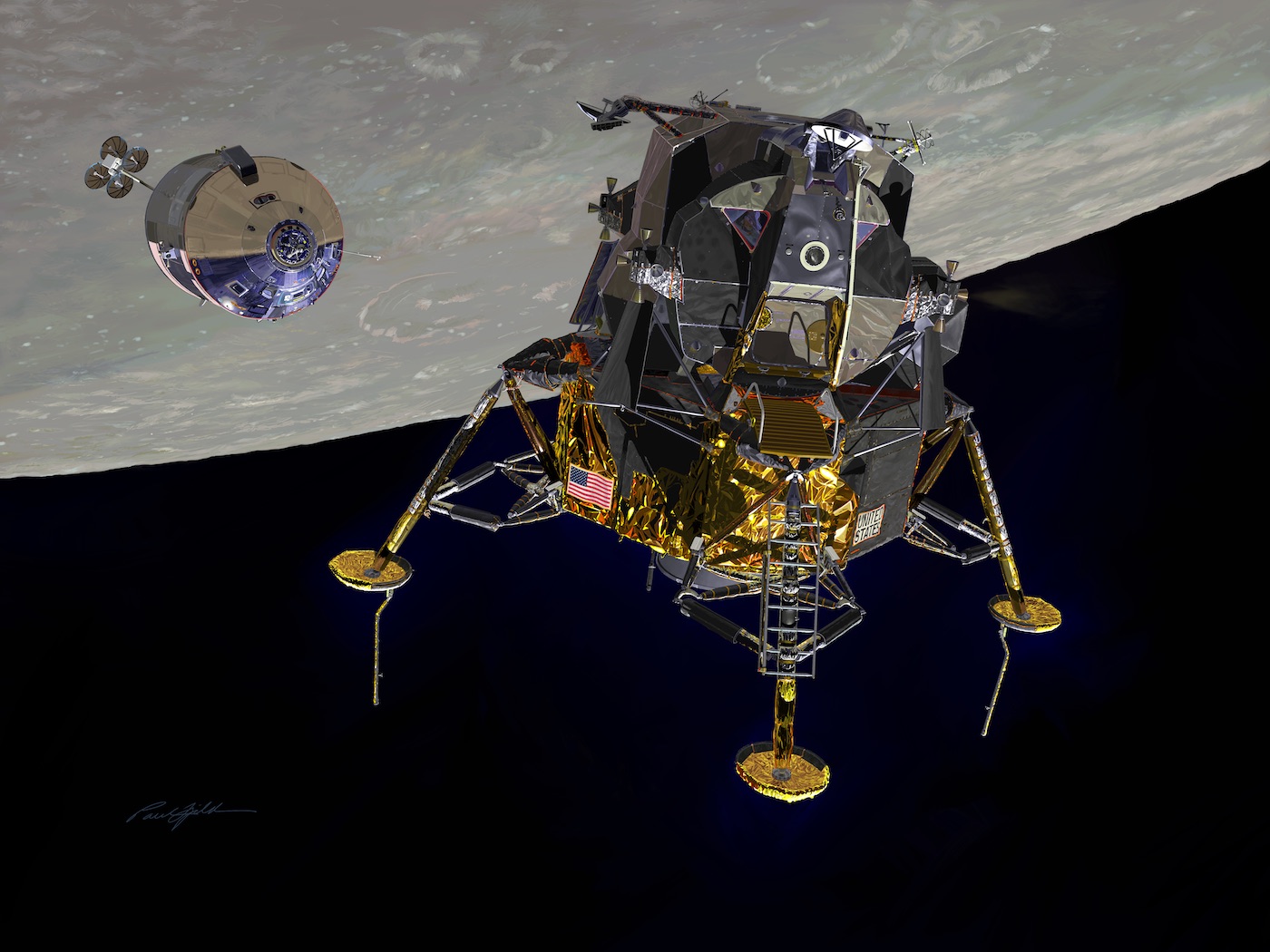
There are beautiful photos and some fairly nice film of the moment of Apollo 11's undocking but this angle, I think, captures it best. The Lunar Module Eagle has been released and while hanging there, Mike Collins in Columbia has pulled back to let Neil Armstrong do a nice pirouette, angled slightly up to show off Eagle's legs. The painting shows King crater in the background as they fly in tandem, in the lunar high noon, a minute away from an AOS with Houston. And it's Collins who's upside down.
This is not a computer render, but digitally "painted" with the Procreate app on an iPad Pro.
A print is available.
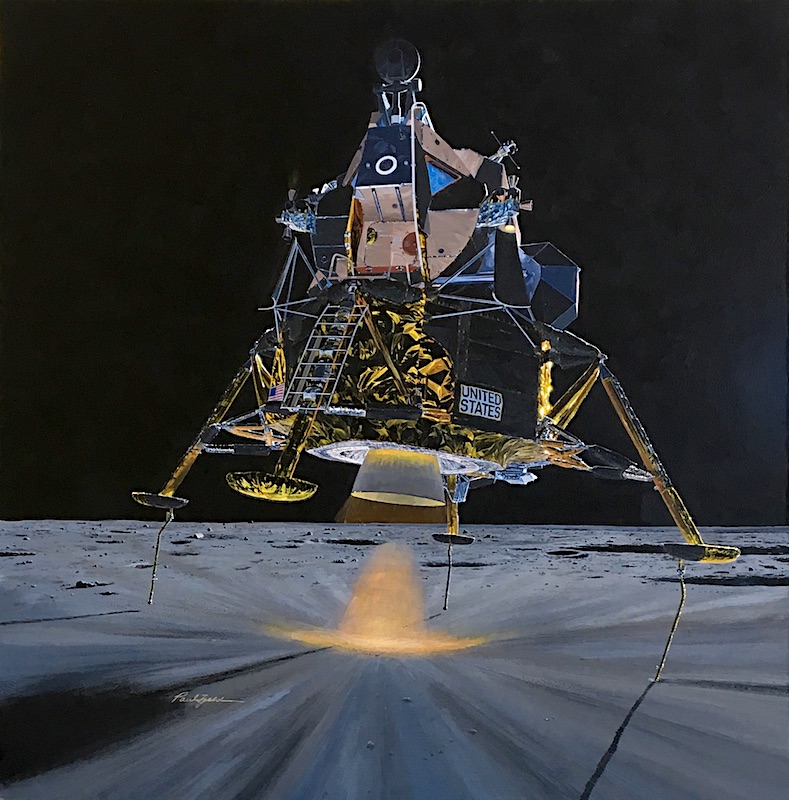
The moment Apollo 11's Eagle could be said to be safely down was when its left-hand probe (on the right here) made contact with the lunar surface. Neil Armstrong started drifting right then began to over-correct to his left. The engine nozzle was glowing, radiating heat from the engine burn. Its plume slammed into the moon, spraying dust and "swallowing" a shock bouncing back into the exhaust. A few seconds later, Eagle slid to a stop on another heavenly body.
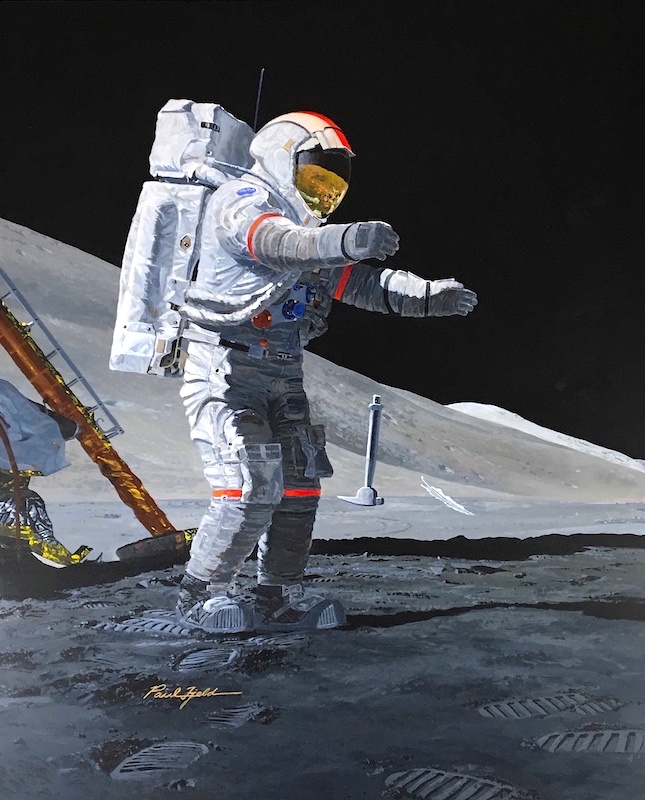
At the end of Apollo 15's last lunar excursion, the commander, Dave Scott, did a beautiful, simple yet profound demonstration of a thought experiment attributed to Galileo 360 years earlier — that dissimilar objects of different weight fall at the same rate, contrary to Aristotle's belief that they were attracted to the earth proportionally to their weight. Scott held out a Falcon feather, for their Falcon Lunar Module, and the geologic hammer he'd been using thoughout their explorations. The LM pilot Jim Irwin said "I've gotta see this!" Scott dropped them in the lunar vacuum and, pulled by the moon's gravity, they landed at the same time, proving Galileo right. "How about that?" he said. "Outstanding!" radioed capcom Joe Allen, who's idea it was.
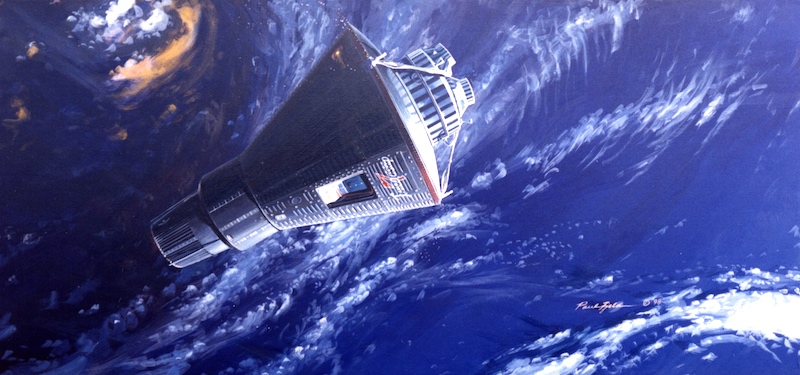
The first American to orbit the earth was John Glenn. He did so three times during the Mercury Atlas 6 mission, sailing on a "new ocean" that only Yuri Gagarin had experienced before him. Glenn was greeted by three sunsets and sunrises in four hours, night passes under moonlight over the lit cities beneath him, and one unexpected thrill. At the first sunrise he was shocked to see a flurry of brilliantly lighted particles like fireflies swirl around the capsule. This was a real mystery until Scott Carpenter, who flew after him, discovered that they were ice particles from the spacecraft itself. The view here shows a few of the fireflies with his capsule Friendship 7, flying over a sunrise terminator.
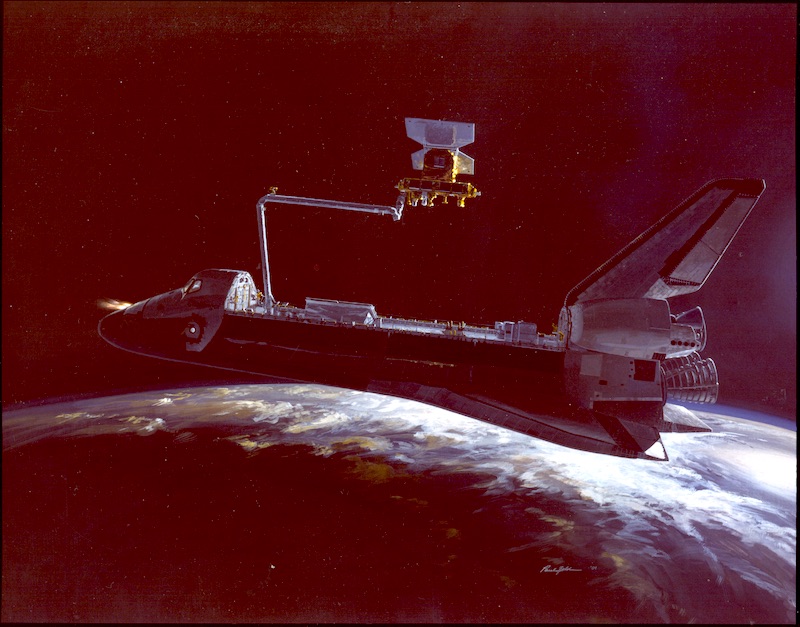
The first Canadian to fly into space was Marc Garneau on the Shuttle mission 41G in 1984. One of the payloads deployed was the Earth Radiation Budget Satellite, shown here at the end of the Canadian Remote Manipulator System, or Canadarm. Before it was released, an important series of tests was conducted to see how well the position of the payload could be determined by TV images of target dots affixed to the ERBS solar arrays. This was the first time target dots were used in the shuttle program and Canada perfected the technique into an Avanced Vision System which became a key technology that helped the International Space Station be assembled in orbit. Today you can see these vision system dots all over the station. For the painting, I got one thing wrong. I have two jets of the primary system firing out the nose. It looked cool, but they used only the little vernier jets to get into position and then went free float at release.
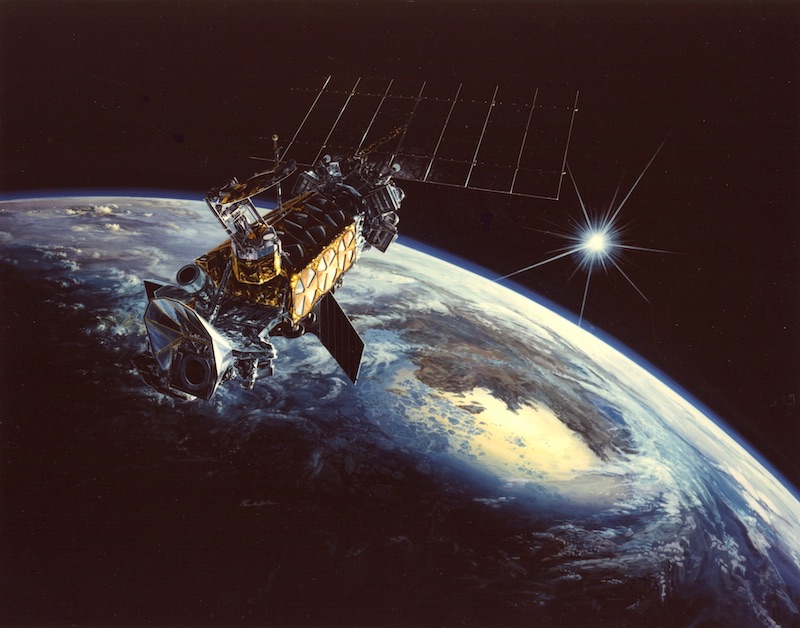
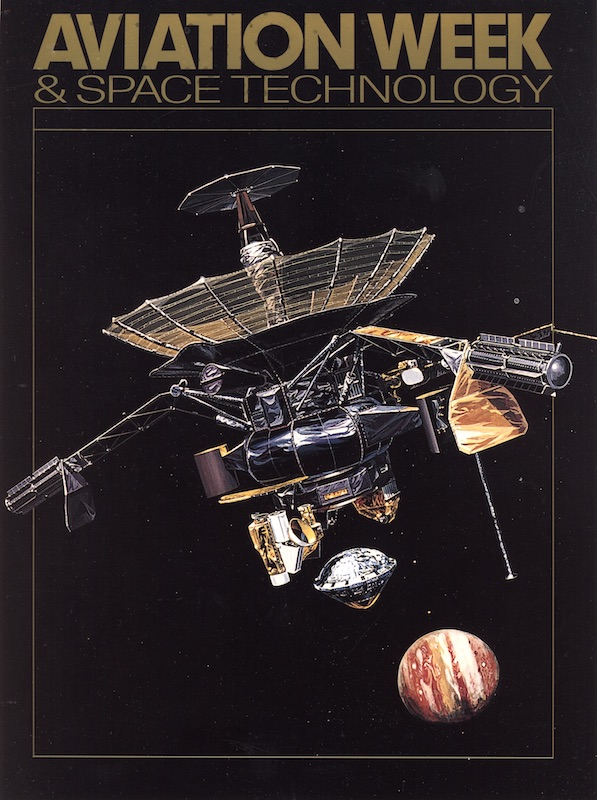
The Galileo spacecraft to Jupiter was supposed to look like this when it dropped off its probe to whack into the giant planet, but the painting was done before Galileo was launched and embarked on a grueling Venus, Earth, Earth, Gravity Assisted journey. After the tragedy of the Challenger disaster, Galileo lost its powerful Centaur upper stage and had to use a weaker one and fly later. While waiting, two of the ribs of its large deployable hi-gain antenna got stuck and never deployed in flight, so all of the fantastic images it took had to be dribbled out through its low gain antenna. Despite that, Galileo was a great success and I wish I re-painted the picture.
When it finally launched in October, 1989, I was there. I got to ask Dick "Spe" Spehalski, the program manager, if Galileo would have blown up had it launched two years earlier, as there had been an undiscovered problem with the spacecraft thrusters. He said yes! Then, the day before launch, I hung out with the Project Scientist Torrence Johnson while we watched the Rotating Service Structure pivot to reveal the Shuttle. That was neat.
And, to paraphrase, there was no thrill that got me like when I got my picture on the cover of Aviation Week.
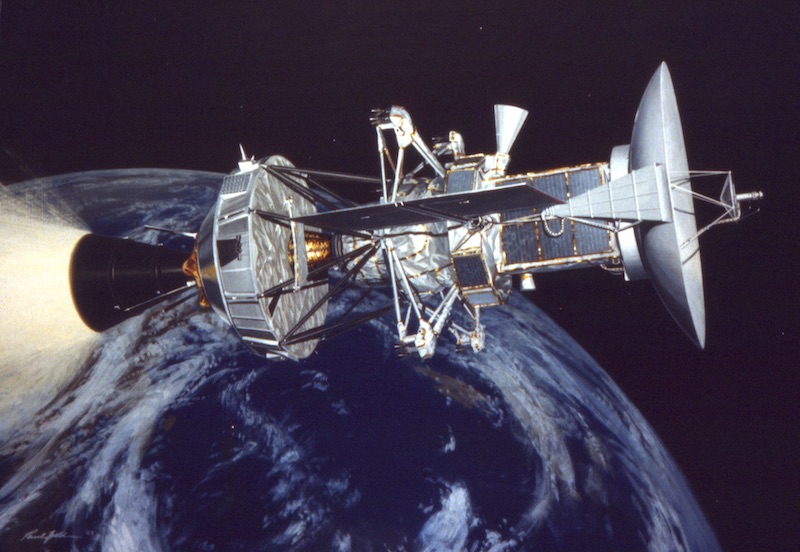
One of the things I like to do is illustrate unusual configurations never seen in photos like here with the final kick of the Magellan Venus Probe into its "trans Venus trajectory." What you see is the second stage of the Inertial Upper Stage firing through its extended nozzle. Magellan took a year and three months to get to Venus by a looping solar trajectory. It arrived in August, 1990 and spent more than four years radar mapping the venusian surface.
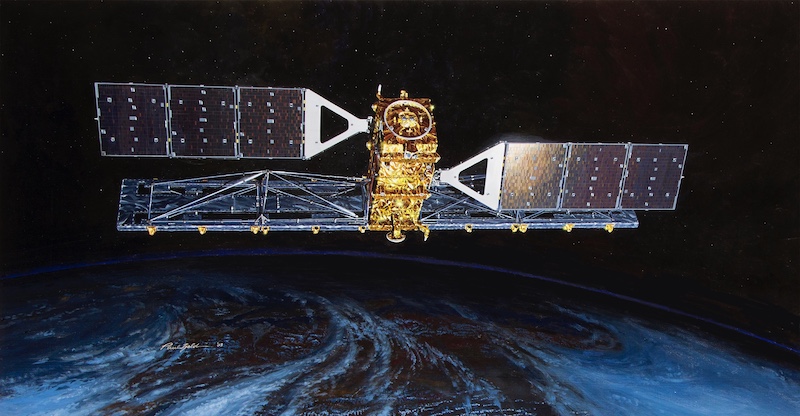
Here is another radar mapper, this one built by Canada and launched in 2007. The problem of doing an accurate painting of a vehicle before it is built is made easier if you have access to technical documentation. Fortunately I had access to the Critical Design Review data package and everything that went onto the spacecraft was detailed. Also I had access to the program manager to help me when I didn't understand some aspect of the engineering. I did the painting for MDA (MacDonald, Dettwiler) in Vancouver BC, which can be seen in the background from this position in Radarsat 2's dawn/dusk orbit.
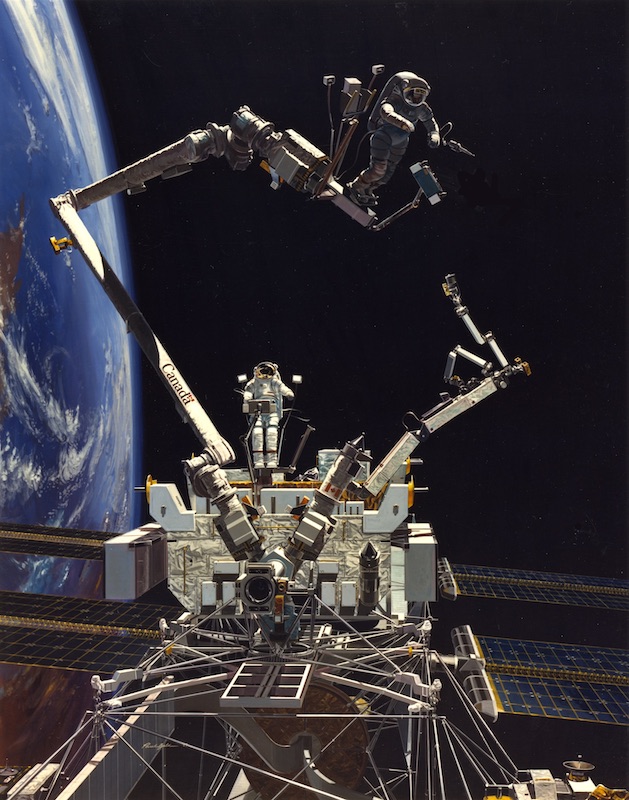
In 1986 I got a call from Canada's space station program director, Karl Doetch. He invited me to Ottawa, gave me a cool presentation of Canada's role on the station, and asked if I'd like to do some paintings of what they developed. Yes I said! Over the course of eight years I did a number of illustrations for the program and this is an example. It shows an early design of Canada's Mobile Service System, which had a base, an arm, and a handy little robot-like manipulator. The early station design had these big five meter bays, assembled on orbit, to which a weird shuffling contraption would move Canada's servicer along. It was neat, bizarre, and didn't survive the "Fisher Price" study. An astronaut and an engineer figured out that by the time we were done building the Freedom Space Station we would have to spend all our time repairing it. This caused a massive redesign including the MSS. As you will see below.
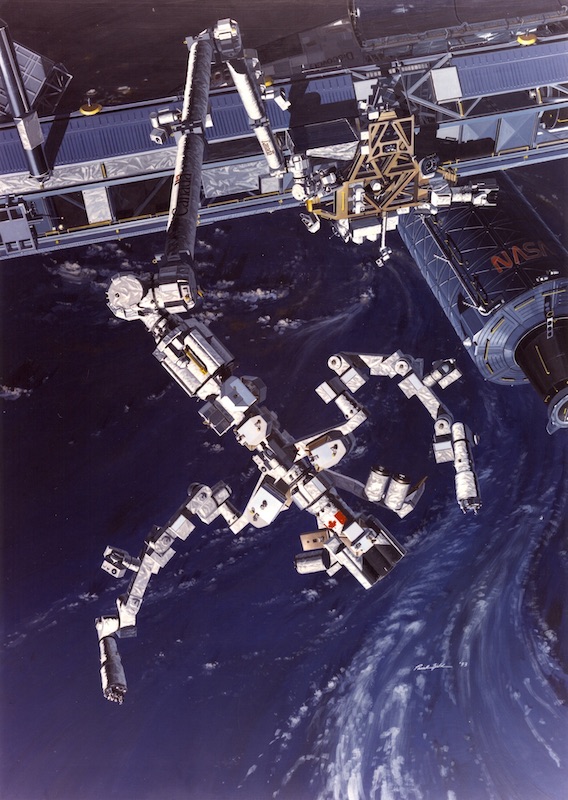
Here is the redesigned, scrubbed, delta'd version of Canada's Mobile Service System (MSS) after 1993's Freedom death and Alpha rebirth. Instead of 5 meter bays built tinker-toy style on orbit, there would be PITs (Pre-integrated Trusses), fully outfitted but smaller modules, and less mass per launch since we were now flying with the Russians and had to go into a higher inclination orbit. Some folks called the station "Ralpha" because of this, but it eventually became the ISS for International Space Station. Canada had the MSS, consisting of the SSRMS (Space Station Remote Manipulator System), the SPDM (Special Purpose Dextrous Manipulator) and the MBS (I'm tired... the base). The SSRMS became Canadarm 2 after a long effort to be creative and the SPDM was named Dextre, which is clever and bilingualish. Throughout its development people tried to pronounce the initials but it sounded stupid. I was pushing "Speedy" for "Speedy Em". It never took.

Dave Williams flew for the first time on STS-90, the Neurolab mission with the Spacelab module. I had known Dave at the Canadian Space Agency and now I asked him if I could do the mission patch. He suggested it to the commander Rick Searfoss and the crew and they agreed I should give it a shot. I was anxious to do a job that they would all like but how to you satisfy seven different tastes? First, calibration. I had them pick their three top patches excluding the ones they'd flown previously. Then iteration. I did three different ones but Rick said he'd be happy to fly with any of them. Not helpful! I did have one particular design that focussed on a blob shape for a neuron and started playing with it, honing the design until everyone was happy (I hoped). The design here is the final that we agreed on. It got squished a bit in the official version and the graphic colors got messed up but not those for the cloth patch. Note the little "EV rat" in the payload bay and the "EV snail" on the OMS pod. The ones used in the flight experiments were not so lucky.

STS-100 would fly with another Canadian I knew, Chris Hadfield. He linked me with the crew's "patch master" Scott "Too Tall" Parazynski who immediately sent me the design I was to execute. So this was easier, but maybe less fun? Scott was great, though, and I could add a few flourishes that tied his design together, including the backdrop favored by Chris — a sunrise from orbit. It all went well and the patch got through approvals and flew like a dream. It looked good as a cake, a tradition before each flight, and better when I got my signed flight poster with a flown example attached.

By his next mission, Scott Parazynski had me on speed dial and I had Dave on a crew again. This time Scott had several ideas for a design that included a flag, a neat angle on the shuttle — I suggested the re-entry configuration — and some kind of educational element because Barbara Morgon, the teacher and now fully trained astronaut, was going to fulfill the promise of Christa McAuliffe. I came up with a flame of knowledge as the center of a Keplerian orbital diagram with Columbia re-entering. The day after the design was approved, Columbia re-entered for the last time, killing its crew. I sent my deepest condolences to Scott and the crew, who were pretty devastated, and knew that if STS-118 ever flew, it would not be with a design of mine. I was right.
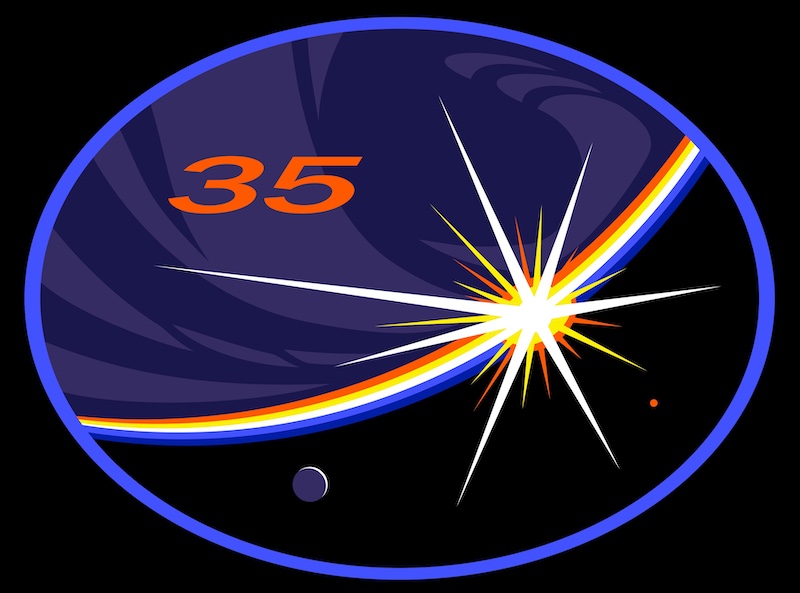
So I had "retired" from doing mission patches and all was well until Chris Hadfield called me and said he had a command. So unretire, aready! There would be only three principals to satisfy now including Tom Marshburn and Roman Romanenko. We agreed on some initial ideas and I did some preliminary designs and they all bombed. Chris suggested we have a conversation with all concerned and I got to spend nearly an hour pegging their "space adventure meters." They were off-scale high. The sense of speed, of spookiness of the black sky in daytime, the earth "above" them (from the perspective of the viewing cupola), and much more. I digested it and this design popped out of my head. Some minor tweaks, a real conversation about having no names, and it cleared NASA officials with no changes. So now I am done with patches. Unless Artemis 3 flies...